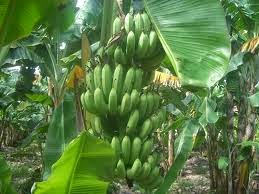BANANA (Musa spp) is now easily amenable to in vitro culture, and plants are regenerated from various explants through organogenesis, embryogenesis, anther culture and even from cultured protoplasts. This has created great opportunities for other biotechnological applications. Cell suspensions, for example, opened the way for gene transfer and improved the production, the quality, and therefore the manipulation of cell suspension-derived protoplasts. Through genetic engineering it has become possible to confer new traits on banana plants, using either particle bombardment or Agrobacterium-mediated transfer. Protoplasts facilitate the direct transformation of plant cells by DNA microinjection and electroporation. However, many characters of agricultural interest are multigenic or ill-defined, and current transformation methodologies allow the integration of only a few foreign genes. Protoplast fusion, however, allows the transfer of several useful characters, even if detailed genetic or molecular knowledge of genes encoding for these desired characters is lacking. Protoplast fusion is therefore a complementary tool to increase nuclear and cytoplasmic variability and to confer desirable agronomic traits.
Important banana cultivars are susceptible to many pests and diseases, particularly Mycosphaerella fijiensis and Fusarium oxysporum f.sp. cubense, nematodes and insects. Very interesting traits of resistance have been identified in this genus for most serious diseases. However cross-breeding is very difficult in the genus since most edible cultivars are sterile even after profuse pollination by wild pollen-fertile genotypes. Protoplast fusion is therefore an option, as it can overcome such sexual barriers which occur frequently in banana, and which cannot be bypassed even through embryo rescue. Therefore somatic hybridisation between wild and cultivated banana is expected to produce hybrids combining agronomic traits with genetic resistance to pests and pathogens.
Protoplast fusion has the added benefit that it creates the possibility of generating asymmetric fusions, whereby selected cytoplasmic organelles, chromosomes or chromosome fragments from an irradiated protoplast donor could be combined with the genome of an acceptor protoplast. This strategy is of especial interest in banana, where the subspecies balbisiana is considered to be a source of multiple resistance and therefore could be partially utilised to improve banana cultivars, of which the most important component is the subspecies acuminata. Protoplast fusion also makes the creation of synthetic triploid banana genotypes possible by, for example, combining haploid protoplasts derived from anther culture with protoplasts from a diploid improved cultivar.
Chimerism and somaclonal variation are factors that seriously limit rapid clonal propagation of banana. By their nature, protoplasts avoid chimerism because they originate from a single cell, and protoplasts may be use to dissociate chimeric plants. On the other hand the cellular heterogeneity of protoplast populations can be useful for isolating somaclonal variants with improved characters such as increased yield or pathogenic resistance, so that somaclonal variation may also be exploited to provide new sources of genetic variability. Banana protoplast isolation and culturing is nowadays routine, although protoplast research on banana started 15 years later than on model plants. Now it is regrettably underused because of the strong emphasis on molecular and genomic studies in banana. Nevertheless, protoplasts have much to offer for non-conventional banana breeding, since they overcome sexual incompatibilities at interspecific and even at the intergeneric level, and allow the incorporation of multigenic traits such as yield, resistance to stress, pests and diseases. Finally protoplast techniques may improve banana when other classical methods have failed. Thanks. Adapted from:http://www.fao.org/docrep/007
By,
M Anem,
Senior Agronomist
Banana Gropu Farming Project,
Kg Air Kuning, Gemenceh,
Negeri Sembilan,
Malaysia.
(6 Rejab 1436H)





No comments:
Post a Comment